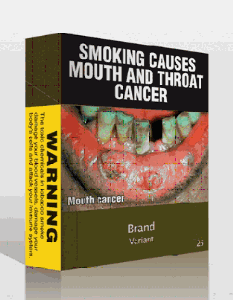
On April 7, 2011, the Federal Government of Australia released the plain packaging design (see the image on the side of this post) that cigarette manufacturers will be forced to adopt when a proposed legislation will come into force, possibly on January 1, 2012. All cigarette packets should then use olive green, a colour supposed to be dull, and reproduce not very attractive photos of smoking-related diseases. Significantly, cigarette manufacturers will be prevented to use their logos, trademarked colors of promotional texts. “The only thing to distinguish one brand from another will be the brand and product name in a standard colour, standard position and standard font size and style” according to the Nicola Roxon, the Australian Health Minister (see Finantial Times, 7 April 2011). Other governments, for example in the UK and Canada, are considering to adopt similar legislation on plain packaging. The tobacco industry is concerned as this new limitation on the way their products can be marketed might significantly reduce their sales.
Some claim that imposed plain packaging amounts to a taking or expropriation of intellectual property.
Do you think such a legislation would encroach on the protection granted by the intellectual property laws or by fundamental rights, such as freedom of expression and property? In particular, are the international rules on IP, such as those included in the Paris Convention and the TRIPs Agreement, violated by such a law?
This is the question I would like you to think about.
There are a lot of sources available on line. The tobacco industry of course has its view on the issue (see for example here). On the contrary, some academics think the tobacco industry’s case is weak (here).

